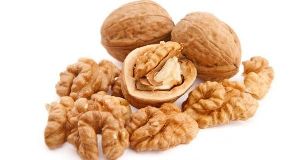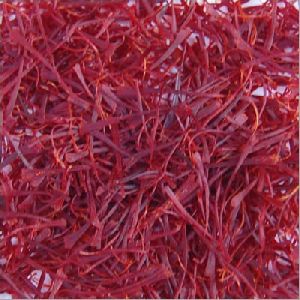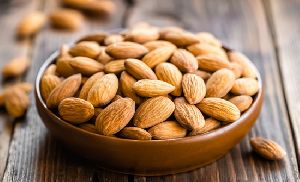
Walnuts
1,200 Per Kilogram
100 % ORGANIC KASHMIR WALNUT KERNALS A walnut is the nut of any tree of the genus Juglans (Family Juglandaceae), particularly the Persian or English walnut, Juglans regia. Technically a walnut is the seed of a drupe or drupaceous nut, and thus not a true botanical nut. It is used for food after being processed while green for pickled walnuts or after full ripening for its nutmeat. Nutmeat of the eastern black walnut from the Juglans nigra is less commercially available, as are butternut nutmeats from Juglans cinerea.
...more
Shilajit
30 Per Gram
100% ORGANIC SHILAJIT Shilajit comes from the Sanskrit compound word shilajatu meaning "rock-conqueror", which is the regular Ayurveda term. It is also spelled shilajeet (Hindi: शिलाजीत) and salajeet (Urdu: سلاجیت). Shilajit is known universally by various other names,[6] such as mineral pitch or mineral wax in English, black asphaltum, Asphaltum punjabianum in Latin, also locally as shargai, dorobi, barahshin, baragshun (Mongolian: Барагшун), mumlai (Farsi مملایی), tasmayi (Kazakh: тасмайы),[7] brag zhun (Tibetan: བྲག་ཞུན་), chao-tong, wu ling zhi (Chinese: 五灵脂, which generally refers to the excrement of flying squirrels), baad-a-ghee (Wakhi for "devil's feces"), and arkhar-tash (Kyrgyz: архар-таш).[6] The most widely used name in the former Soviet Union is mumiyo (Russian: мумиё, variably transliterated as mumijo, mumio, momia, and moomiyo), which is ultimately from Persian mūmiyā (مومیا).
...more
Pure Kashmiri Saffron
Saara brings you the world's purest saffron selected from the best of the season's crop from the karewa lands of kashmir valley. It is fresh, healthy and the strongest in aroma with a lasting fragrance. Saara saffron adds beautiful flavour, colour and its strong aroma to the dishes, gravies and various desserts. It has enormous health benefits that keeps your body fit, your skin healthy and keeps you going. Health Benefits of Saffron : - It is considered as a powerful antidepressant. - Improves digestion and helps in weight loss. - Helps improve vision and protects the retina from damaging. - Helps cure respiratory diseases. - Treats cancers, asthma, menstrual cramps, depression and insomnia. - Alleviates anxiety and it rejuvenates the mind. - It is considered to be a pain reliever. Medicinal Uses : - The active components present in saffron have many therapeutic applications in many traditional medicines since long time as anti-spasmodic, carminative, diaphoretic. - Safranal, a volatile oil found in the spice, has antioxidant, cytotoxic effect on cancer cells, anticonvulsant and antidepressant properties. - Alfa-crocin, a carotenoid compound, which gives the spice its characteristic golden-yellow hue, has been found to have anti-oxidant, anti-depressant, and anti-cancer properties.
...more
kashmiri Saffron
230 Per Gram
100 % ORGANIC KASHMIRI SAFFRON ( KESAR ) Saffron (pronounced ˈsæfrən or ˈsæfrɒn)[1] is a spice derived from the flower of Crocus sativus, commonly known as the "saffron crocus". The vivid crimson stigmas and styles, called threads, are collected and dried to be used mainly as a seasoning and colouring agent in food. Saffron, long among the world's most costly spices by weight,[2][3][4] was probably first cultivated in or near Greece.[5] C. sativus is probably a form of C. cartwrightianus, that emerged by human cultivators selectively breeding plants for unusually long stigmas in late Bronze Age Crete.[6] It slowly propagated throughout much of Eurasia and was later brought to parts of North Africa, North America, and Oceania. Saffron's taste and iodoform or hay-like fragrance result from the chemicals picrocrocin and safranal.[7][8] It also contains a carotenoid pigment, crocin, which imparts a rich golden-yellow hue to dishes and textiles. Its recorded history is attested in a 7th-century BC Assyrian botanical treatise compiled under Ashurbanipal,[9] and it has been traded and used for over four millennia. Iran now accounts for approximately 90% of the world production of saffron.
...more
Honey Products
800 Per Kilogram
100% organic, white himalayan wild honey honey is a sweet, viscous food substance produced by bees and some related insects.[1] bees produce honey from the sugarysecretions of plants (floral nectar) or other insects (aphid honeydew) through regurgitation, enzymatic activity, and water evaporation, and store it in wax structures called honeycombs.[1][2] the variety of honey produced by honey bees (the genus apis) is the best-known, due to its worldwide commercial production and human consumption.[3] honey is collected from wild bee colonies, or from hives of domesticated bees, a practice known as beekeeping.
...more
Almonds
1,000 Per Kilogram
KASHMIRI ALMONDS The almond (Prunus dulcis, syn. Prunus amygdalus) is a species of tree native to the Middle East, the Indian subcontinent and North Africa. Almond is also the name of the edible and widely cultivated seed of this tree. Within the genus Prunus, it is classified with the peach in the subgenus Amygdalus, distinguished from the other subgenera by corrugations on the shell (endocarp) surrounding the seed. The fruit of the almond is a drupe, consisting of an outer hull and a hard shell with the seed, which is not a true nut, inside. Shelling almonds refers to removing the shell to reveal the seed. Almonds are sold shelled or unshelled. Blanched almonds are shelled almonds that have been treated with hot water to soften the seedcoat, which is then removed to reveal the white embryo.
...moreBe first to Rate
Rate ThisOpening Hours